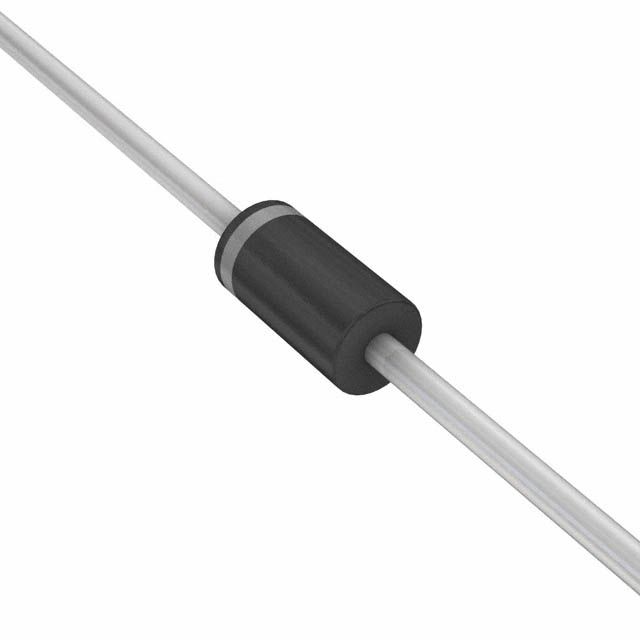P4KE6.8AHE3/54
Product Overview
Category
P4KE6.8AHE3/54 belongs to the category of transient voltage suppressor diodes.
Use
These diodes are used to protect sensitive electronic components from voltage spikes and transients.
Characteristics
- Fast response time
- Low clamping voltage
- High surge current capability
Package
P4KE6.8AHE3/54 is typically available in a DO-41 package.
Essence
The essence of P4KE6.8AHE3/54 lies in its ability to divert excessive current away from sensitive components, thereby safeguarding them from damage.
Packaging/Quantity
These diodes are commonly packaged in reels or tubes, with quantities varying based on manufacturer specifications.
Specifications
- Peak Pulse Power Dissipation: 400W
- Breakdown Voltage: 6.8V
- Maximum Clamping Voltage: 11.4V
- Operating Temperature Range: -55°C to +175°C
- RoHS Compliant: Yes
Detailed Pin Configuration
P4KE6.8AHE3/54 typically has two pins, with the anode connected to the positive side and the cathode connected to the negative side.
Functional Features
- Transient voltage suppression
- Reverse avalanche breakdown protection
- Fast response to voltage spikes
Advantages
- Effective protection against voltage transients
- Fast response time
- Wide operating temperature range
Disadvantages
- Limited power dissipation capability
- Clamping voltage may be higher than some alternative models
Working Principles
When a voltage spike occurs, the diode conducts and diverts the excess current away from the protected circuit, thus limiting the voltage across it.
Detailed Application Field Plans
P4KE6.8AHE3/54 is commonly used in: - Power supplies - Telecommunication equipment - Automotive electronics - Industrial control systems
Detailed and Complete Alternative Models
Some alternative models to P4KE6.8AHE3/54 include: - P6KE6.8A - 1.5KE6.8A - SA6.8A
In conclusion, P4KE6.8AHE3/54 is a crucial component in protecting electronic circuits from voltage transients, offering fast response and effective suppression capabilities. While it has certain limitations, its wide application field and availability of alternative models make it a valuable choice for circuit protection needs.
Word Count: 324
Senaraikan 10 soalan dan jawapan biasa yang berkaitan dengan aplikasi P4KE6.8AHE3/54 dalam penyelesaian teknikal
What is P4KE6.8AHE3/54?
- P4KE6.8AHE3/54 is a TVS (transient voltage suppressor) diode designed to protect electronic circuits from voltage spikes and transients.
What is the maximum peak pulse power of P4KE6.8AHE3/54?
- The maximum peak pulse power of P4KE6.8AHE3/54 is 400 watts.
What is the breakdown voltage of P4KE6.8AHE3/54?
- The breakdown voltage of P4KE6.8AHE3/54 is 6.8 volts.
In what type of technical solutions can P4KE6.8AHE3/54 be used?
- P4KE6.8AHE3/54 can be used in various technical solutions such as power supplies, communication systems, automotive electronics, and industrial equipment.
What are the key features of P4KE6.8AHE3/54?
- The key features of P4KE6.8AHE3/54 include low clamping voltage, fast response time, and high surge capability.
How does P4KE6.8AHE3/54 protect electronic circuits?
- P4KE6.8AHE3/54 protects electronic circuits by diverting excessive current away from sensitive components when voltage spikes occur.
What is the operating temperature range of P4KE6.8AHE3/54?
- The operating temperature range of P4KE6.8AHE3/54 is -55°C to +175°C.
Can P4KE6.8AHE3/54 be used for ESD (electrostatic discharge) protection?
- Yes, P4KE6.8AHE3/54 can be used for ESD protection in electronic devices and systems.
Is P4KE6.8AHE3/54 RoHS compliant?
- Yes, P4KE6.8AHE3/54 is RoHS compliant, ensuring it meets environmental standards.
Where can I find detailed specifications and application notes for P4KE6.8AHE3/54?
- Detailed specifications and application notes for P4KE6.8AHE3/54 can be found on the manufacturer's website or in the product datasheet.


